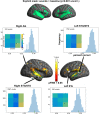FMRI-based identity classification accuracy in left temporal and frontal regions predicts speaker recognition performance
- PMID: 33436825
- PMCID: PMC7803954
- DOI: 10.1038/s41598-020-79922-7
FMRI-based identity classification accuracy in left temporal and frontal regions predicts speaker recognition performance
Abstract
Speaker recognition is characterized by considerable inter-individual variability with poorly understood neural bases. This study was aimed at (1) clarifying the cerebral correlates of speaker recognition in humans, in particular the involvement of prefrontal areas, using multi voxel pattern analysis (MVPA) applied to fMRI data from a relatively large group of participants, and (2) at investigating the relationship across participants between fMRI-based classification and the group's variable behavioural performance at the speaker recognition task. A cohort of subjects (N = 40, 28 females) selected to present a wide distribution of voice recognition abilities underwent an fMRI speaker identification task during which they were asked to recognize three previously learned speakers with finger button presses. The results showed that speaker identity could be significantly decoded based on fMRI patterns in voice-sensitive regions including bilateral temporal voice areas (TVAs) along the superior temporal sulcus/gyrus but also in bilateral parietal and left inferior frontal regions. Furthermore, fMRI-based classification accuracy showed a significant correlation with individual behavioural performance in left anterior STG/STS and left inferior frontal gyrus. These results highlight the role of both temporal and extra-temporal regions in performing a speaker identity recognition task with motor responses.
Conflict of interest statement
The authors declare no competing interests.
Figures





Similar articles
-
How the human brain recognizes speech in the context of changing speakers.J Neurosci. 2010 Jan 13;30(2):629-38. doi: 10.1523/JNEUROSCI.2742-09.2010. J Neurosci. 2010. PMID: 20071527 Free PMC article.
-
Task-dependent decoding of speaker and vowel identity from auditory cortical response patterns.J Neurosci. 2014 Mar 26;34(13):4548-57. doi: 10.1523/JNEUROSCI.4339-13.2014. J Neurosci. 2014. PMID: 24672000 Free PMC article.
-
T'ain't what you say, it's the way that you say it--left insula and inferior frontal cortex work in interaction with superior temporal regions to control the performance of vocal impersonations.J Cogn Neurosci. 2013 Nov;25(11):1875-86. doi: 10.1162/jocn_a_00427. Epub 2013 May 22. J Cogn Neurosci. 2013. PMID: 23691984 Free PMC article.
-
Segmental processing in the human auditory dorsal stream.Brain Res. 2008 Jul 18;1220:179-90. doi: 10.1016/j.brainres.2007.11.013. Epub 2007 Nov 17. Brain Res. 2008. PMID: 18096139 Review.
-
Stimulus-dependent activations and attention-related modulations in the auditory cortex: a meta-analysis of fMRI studies.Hear Res. 2014 Jan;307:29-41. doi: 10.1016/j.heares.2013.08.001. Epub 2013 Aug 11. Hear Res. 2014. PMID: 23938208 Review.
Cited by
-
Visual Deprivation Alters Functional Connectivity of Neural Networks for Voice Recognition: A Resting-State fMRI Study.Brain Sci. 2023 Apr 7;13(4):636. doi: 10.3390/brainsci13040636. Brain Sci. 2023. PMID: 37190601 Free PMC article.
-
Aberrant functional hubs and related networks attributed to cognitive impairment in patients with anti‑N‑methyl‑D‑aspartate receptor encephalitis.Biomed Rep. 2024 May 22;21(1):104. doi: 10.3892/br.2024.1792. eCollection 2024 Jul. Biomed Rep. 2024. PMID: 38827495 Free PMC article.
-
Cortical-striatal brain network distinguishes deepfake from real speaker identity.Commun Biol. 2024 Jun 11;7(1):711. doi: 10.1038/s42003-024-06372-6. Commun Biol. 2024. PMID: 38862808 Free PMC article.
-
Perspective-taking is associated with increased discriminability of affective states in the ventromedial prefrontal cortex.Soc Cogn Affect Neurosci. 2022 Dec 1;17(12):1082-1090. doi: 10.1093/scan/nsac035. Soc Cogn Affect Neurosci. 2022. PMID: 35579186 Free PMC article.
-
Unveiling the development of human voice perception: Neurobiological mechanisms and pathophysiology.Curr Res Neurobiol. 2024 Mar 8;6:100127. doi: 10.1016/j.crneur.2024.100127. eCollection 2024. Curr Res Neurobiol. 2024. PMID: 38511174 Free PMC article. Review.
References
-
- Aglieri, V. et al. The glasgow voice memory test: assessing the ability to memorize and recognize unfamiliar voices. Behav. Res. Methods 1–14 (2016). - PubMed
Publication types
MeSH terms
LinkOut - more resources
Full Text Sources
Other Literature Sources
Medical

